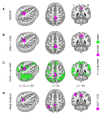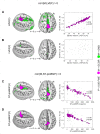Brain dysconnectivity with heart failure
- PMID: 37091590
- PMCID: PMC10116577
- DOI: 10.1093/braincomms/fcad103
Brain dysconnectivity with heart failure
Abstract
Structural brain damage associated with heart failure is well described; however, little is known about associated changes in various specific brain functions that bear immediate clinical relevance. A satisfactory pathophysiological link between heart failure and decline in cognitive function is still missing. In the present study, we aim to detect functional correlates of heart failure in terms of alterations in functional brain connectivity (quantified by functional magnetic resonance imaging) related to cognitive performance assessed by neuropsychological testing. Eighty patients were post hoc grouped into subjects with and without coronary artery disease. The coronary artery disease patients were further grouped as presenting with or without heart failure according to the guidelines of the European Society of Cardiology. On the basis of resting-state functional magnetic resonance imaging, brain connectivity was investigated using network centrality as well as seed-based correlation. Statistical analysis aimed at specifying centrality group differences and potential correlations between centrality and heart failure-related measures including left ventricular ejection fraction and serum concentrations of N-terminal fragment of the pro-hormone brain-type natriuretic peptide. The resulting correlation maps were then analysed using a flexible factorial model with the factors 'heart failure' and 'cognitive performance'. Our core findings are: (i) A statistically significant network centrality decrease was found to be associated with heart failure primarily in the precuneus, i.e. we show a positive correlation between centrality and left ventricular ejection fraction as well as a negative correlation between centrality and N-terminal fragment of the pro-hormone brain-type natriuretic peptide. (ii) Seed-based correlation analysis showed a significant interaction between heart failure and cognitive performance related to a significant decrease of precuneus connectivity to other brain regions. We obtained these results by different analysis approaches indicating the robustness of the findings we report here. Our results suggest that the precuneus is a brain region involved in connectivity decline in patients with heart failure, possibly primarily or already at an early stage. Current models of Alzheimer's disease-having pathophysiological risk factors in common with cerebrovascular disorders-also consider reduced precuneus connectivity as a marker of brain degeneration. Consequently, we propose that heart failure and Alzheimer's disease exhibit partly overlapping pathophysiological paths or have common endpoints associated with a more or less severe decrease in brain connectivity. This is further supported by specific functional connectivity alterations between the precuneus and widely distributed cortical regions, particularly in patients showing reduced cognitive performance.
Keywords: brain connectivity; cognitive impairment; functional magnetic resonance imaging; heart failure; precuneus.
© The Author(s) 2023. Published by Oxford University Press on behalf of the Guarantors of Brain.
Conflict of interest statement
The authors report no competing interests.
Figures





References
-
- Horstmann A, Frisch S, Jentzsch RT, Muller K, Villringer A, Schroeter ML. Resuscitating the heart but losing the brain: Brain atrophy in the aftermath of cardiac arrest. Neurology. 2010;74(4):306–312. - PubMed
-
- Cannon JA, Moffitt P, Perez-Moreno AC, et al. . Cognitive impairment and heart failure: Systematic review and meta-analysis. J Card Fail. 2017;23(6):464–475. - PubMed
LinkOut - more resources
Full Text Sources
